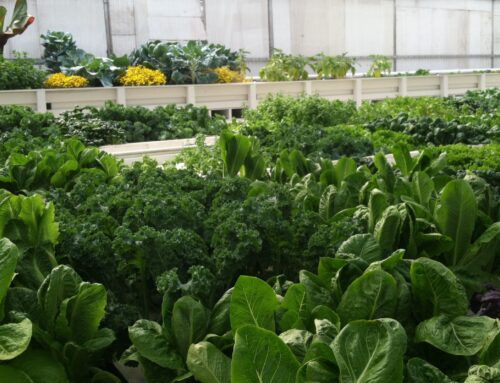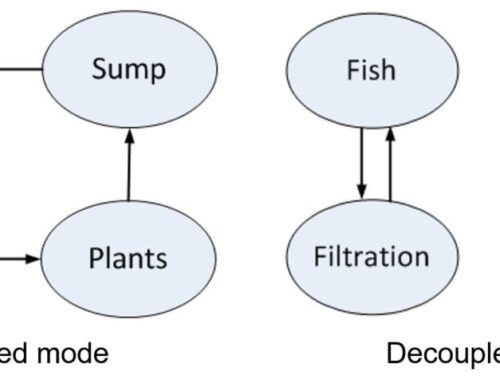10 Easy Steps for Keeping Your Aquaponic System Running Strong, All Year Long
It’s that time of year for Spring cleaning, time to refresh your aquaponic system and make it more abundant and attractive. Here is a quick run down for a super spring time aquaponic spruce up (or really any time of year when you notice there are issues.
- Manage Temperature Fluctuations and Humidity – Now is the time of year when it might get really hot in the day and still very chilly at night. Temperature management is a tricky one. It is especially critical to ensure proper air ventilation through the building, circulating air inside the building and managing heat and humidity the best you can (I know this is tricky for many). High temps and humidity can cause plants to bolt and die or quickly succumb to pest pressure and diseases. Give your plants more space, add fans, keep your vines vertical and properly trimmed of suckers and dead leaf material, and choose your crops for heat tolerance so you’ll have greater productivity. Things that grow well in colder temps like lettuces, kales and chard may suffer as the weather gets warmer. Choose leafy green varieties that are designed for hot temps. Now is also the perfect time to get the vining crops growing that flourish in the longer day length and warm weather. Start the shift to warm weather crops as the temperature in your climate allows. Also remove plants that have lived out their lifecycle. Lettuces, greens and some culinary herbs only live for about 60-90 days, fruiting crops for 90-200 days. If your plants are starting to have yellow or dying leaves, pest pressure, or low production it could be that they are at the end of their traditional life cycle and need to be replaced.
- Beat Down the Bugs – A greenhouse environment allows pests to live year round (unless you choose to grow seasonally). As the days get longer and the crops grow more vigorous, the bugs often grow more out of control. More crop means more to eat and aphids, white flies and other pests love the buffet. The most important thing to do, is stay ahead of the pests. It’s really important to get them while they are young so that they can’t reproduce and make more mouths to feed. All over the internet there are people posting their favorite bug-killing brews. First step, is to try knocking them off with water, blasting them with a gush of air (out of the space if possible), or using alternating remedies of diluted olive oil and water, vinegar and water, dish soap and water. Its best to spray at night when the sun or lights have been off the plant for at least an hour. Never spray anything into the fish tank or onto the media if possible. Also when using a new remedy, its a good idea to test spray a few leaves and wait a few days to see the effect before using a lot of it. You don’t want to destroy your precious plants. Avoid products like Neem oil or Pyrethrum, while they are organic, they are also very toxic to the fish. Check here for additional pest controls.
- Protect your system from the bigger pests and predators – This time of year, people start opening doors, windows or even moving their systems outdoors to help with the heat. This is also the time of year when birds, squirrels, rabbits, deer, mice, and much more are excited to start checking out your garden spaces and sampling the produce. Although they really kick in when you have perfect tomatoes or some prime bell peppers that are worth nibbling a few pecks or tasty bits out of each one. Fish are very susceptible to becoming sushi dinner from the likes of herons, owls and other birds of prey, bull snakes, raccoons and skunk. Being in Colorado, we’ve had customers that have had both bears and moose walk into their greenhouse for a meal (luckily not at the same time), And for those in the southern climates watch out for the alligators. Netting, screen doors, window and vent mesh, and fencing are all a good idea to ensure your plants and fish stay where they belong, not in the belly of a predator. Other things to keep an watch for, are frogs that want to turn your sump tanks and raft beds into a tadpole nursery.
- Keep an Eye on Nutrients – This time of year, plants are taking up more nutrients since there is longer day length. pH can plummet quickly if its not being properly adjusted and maintained with alternating calcium and potassium. Iron loving plants like basil and kale will show yellowing (chlorosis) which will cause permanent damage to the plant, so test and supplement iron before the yellowing starts. In addition, vining and fruiting crops needs a wider variety of micro nutrients than leafy greens, so supplementing those crops at the root base and adding phosphorous for blooming, fruiting and flavor are all useful ways to ensure that your plants, bacteria and fish stay healthy and happy.
- Improve Water Quality – If your fish or sump tank water quality could use a bit of a boost, place a submersible pump in the bottom of the tank, and drain out about 1/3 of the water. Apply the water to fruit trees or kickstart your compost. Refill with the tank with temperate, dechlorinated water. This will keep the fish and bacteria happy while removing some of the thicker solids from the bottom of the tank. Too many solids over time will result in larger concentrations of heterotrophic bacteria which consume solids and out compete with nitrifying bacteria for space and oxygen. This will cause denitrification which will reduce the nitrogen available for the plants. Make sure to flush solids out of the system on a predefined basis, keep filters washed, and minimize the amount of overall solids buildup.
- Check for Thick Solids in the Media beds and Deep Water Culture – Do your growbeds have a lot of solids in them? Does the bottom of your deep water culture filled with sediment? It may be time for a rinse and refresh. While a lot of mineralization goes on to convert fish solids, uneaten feed and algae into plant nutrients, at some point in time, solids will accumulate to a point where they overload the system. When that happens, they can become anaerobic or just too thick for plant roots to absorb anymore. You may have heard that worms help and they do for a while, however, they also produce waste. Eventually, the beds just need some cleaning. We usually do this when we are changing crops out to avoid messing with the mature root systems. Flush the water out of the bed into a bucket or a sump, then siphon or pump out to fruit trees or compost. Try not to wash too much media all at once, since you don’t want to completely disrupt your biofilter in the process.
- Clean Your Pump and Pipes – All of the plumbing components and pump in your system can clog with fish solids, bioslime and bacteria. This can put pressure on your pump and make the water not flow as effectively through your system. Remove these components from your system and clean with a blast of water from a hose, a tool like a rifle barrel cleaner or drier cleaning brush depending upon the size of the pipe. At the same time check the pump components to make sure they are in good working order. It might be time to replace the impeller.
- Maximize Aeration – As temperatures increase, warm water has less ability to hold oxygen. Therefore it is very important to have clean air stones. Dunk the airstones in a bucket of water and a tablespoon or two of hydrogen peroxide and scrub with a brush to remove bioslime. Also check to make sure that the aerator is performing properly. The bubbles in the tank should be as small and fine as possible for the fish gills and plants roots to absorb them.
- Prevent Algae and Duckweed from Taking Over – This time of year it is more common to have abundant algae growth. Make sure to keep exposed water covered to prevent unwanted algae that will consume both nutrients and oxygen. Shading fish tanks, sump tanks or any other exposed areas is also necessary to keep algae to a minimum. This may also require adding some new media to the growbeds if there has been significant settling and you have water above the media. If you use duckweed as a feed supplement, it should be grown in a separate container, then sun dried before feeding to the fish. Both algae and duckweed have very fast and prolific lifecycles and can quickly overwhelm your tank water.
- Boost Good Bacteria – Some people shut down their systems over the winter. Others notice changes in ammonia and nitrite conversion with temperature changes. Bacteria are slower to perform below about 6o F and over 8o F. If you are starting up again for the summer, if you did a “deep clean”, you are introducing new fish into the system, or you just need to boost bacteria concentrations overall, it’s a good idea to purchase some nitrifying bacteria to keep the fish safe.
Taking an hour or two for some spring time maintenance can make a world of difference in the beauty and functionality of your aquaponic system. Give it a little love, and it will return an abundance of good clean food. Share with us how you get your system ready for Spring.


